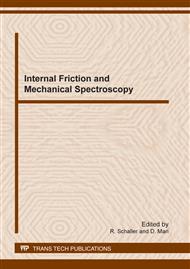p.265
p.271
p.277
p.283
p.289
p.295
p.301
p.307
p.313
The Effect of Annealing on the Internal Friction in ECAP-Modified Ultrafine Grained Copper
Abstract:
A detailed study of anelastic effects in submicrocrystalline copper using resonance (~70 kHz, 2 K to 320 K) and sub-resonance (0.05-100 Hz, 300 K to 675 K) techniques was carried out. Several relaxation processes were found in the temperature range of 2 K - 675 K: the relaxation loss peaks (Q-1) near 35 (P1) and 90K (P2) with the activation energy and the pre-exponential factor (H1 ≈ 0.02 eV, το1 ≈ 10-9 s and H2 ≈ 0.09 eV, το2 ≈ 10-11 s) similar to those of the Bordoni and the Niblett-Wilks peaks in coarse-grained Cu. This suggests that the peaks are due to the thermally activated motion of dislocation kinks in the primary and secondary Peierls relief. The mean values of activation parameters (H3 ≈1.4-1.6 eV, το3 ≈10-17 s) of a third thermally activated peak (P3), which was significantly broadened, can be interpreted as a grain boundary peak with uncoupled activation parameters H3*≈0.45 eV and το3* ≈10-14 s. A pseudo peak PR is associated with irreversible recrystallization processes. The influence of annealing on the observed effects is also discussed.
Info:
Periodical:
Pages:
289-294
Citation:
Online since:
January 2012
Authors:
Price:
Сopyright:
© 2012 Trans Tech Publications Ltd. All Rights Reserved
Share:
Citation:


